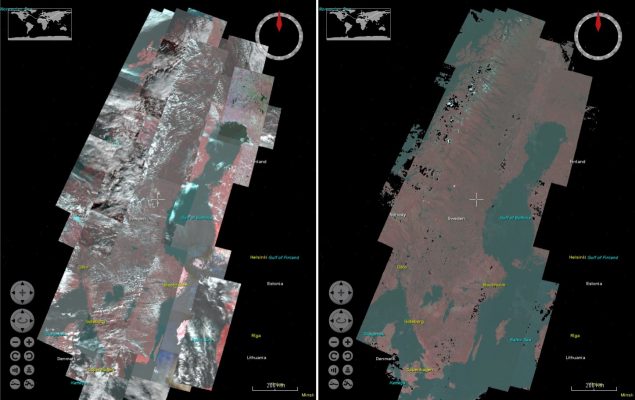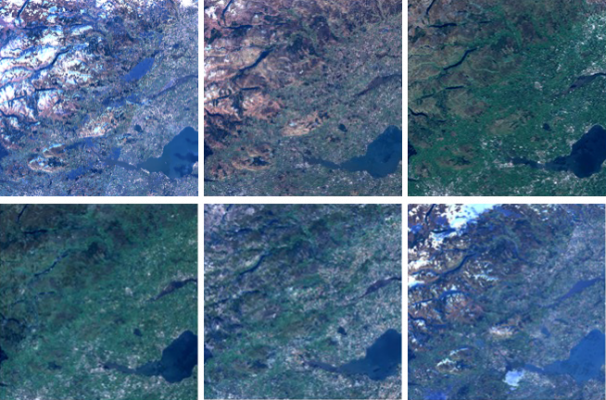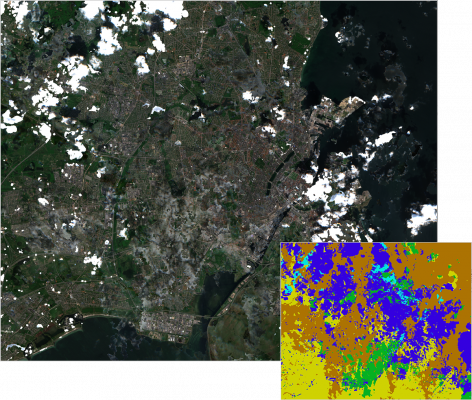You might have recently experienced the advantages of ordering a fresh meal-kit, composed out of your prerequisites, delivered at home: no search for ingredients effort, no raw leftovers, time and fuel savings. All you need to do is prepare and cook.
This can be seen as a tasty analogy for the service developed within the DYNAMOS project, whose main functions are to provide:
- a rapid ‘stitching together’ of multiple Sentinel-2 images to form mosaics automatically, vastly reducing the manual labour required, and based on your initial requirements
- a technical solution that can computationally process the massive data volumes involved, and achieve this both rapidly and cheaply.
Satellite image mosaics have always been the result of a long and demanding process involving significant manual intervention. The manual work ranges from image selection and cloud masking to ensuring images fit together precisely, both geometrically and radiometrically. The creation of mosaics introduces long lead times. The heavy production costs associated with these manual mosaics are due to them being either produced as “one-offs”, or as a limited series of variants.
The dynamic mosaic concept
Dynamic mosaicing is an innovative way of creating image mosaics using automated methods. The Dynamic mosaic concept is based on “recipes” where the mosaic is defined. They state for example: which images to include, how to blend them and define seam-lines, as well as cloud masks and geometric adjustments to ensure a good fit (see figure 1). Such definition is implemented through metadata in a database.

As a result of the small size of the metadata, the “dynamic mosaic” can be modified and used both often and easily. The latest images can always be included so dynamic mosaics can show the current “snapshot” to be compared with earlier results for change analysis applications.
The dynamic mosaic concept is ideal for creating time series (see figure 2). Mosaics for time series can be made automatically for short intervals, for example, a bi-monthly mosaic collecting all images within two weeks.

The approach of generating dynamic mosaics on demand means the results are much more relevant to the user. Standard mosaics are always a compromise and can never fully satisfy the needs of all users that have access to a dataset. By contrast, the specific characteristics of a dynamic mosaic are defined by the user for their specific application. So, for example, forestry users can request a mosaic product that highlights dark woodlands, while agricultural and urban applications can select different spectral bands, radiometric treatments, and resampling to suit their needs.
As a result, the mosaic only exists as a virtual product. It doesn’t need to be generated until required by a user. This introduces big savings on production effort and data storage.
Upgraded mosaics
1 – The dynamic mosaic will be accompanied by details about source images.
Let’s consider the case of the Swedish Forest Authority, in charge of monitoring and detecting clear cuts in forest areas. For such a task it is of utmost importance to keep track of the source of each pixel to be able to determine when a clear cut was made.
This is done by computing a special provenance image and attaching it to the mosaic, showing for each pixel which source image was used. Figure 3 shows a mosaic based on five Sentinel-2 images acquired on 15-28 May 2021 with an attached provenance image. The different source codes can be distinguished by their different colours (dark blue, blue, orange, yellow, and green). The used input images had a cloud cover in the 25-70% range.

2 – The dynamic mosaic can also be made as a composite and include computations such as NDVI.
Figure 4 shows an example of NDVI time series. Each monthly NDVI image is computed from composites based on the average of all images in a two-week interval.

Serverless processing
Traditional approaches to large-scale image processing utilise enterprise-based servers where image processing software is installed on customer-managed hardware. This is suitable for clients who require complete control over their system to offer service, quality, and security assurance. Customers must factor in the costs associated with security, management, and maintenance of the hardware, as well as the costs associated with the staff.
An alternative methodology is offered by cloud-based processing, where the above costs are shared by the users of the system. This approach can offer a lower entry cost for low volume-users since the system is scalable in terms of processing power and storage. Cloud deployment can change the marketplace from a large upfront investment to only the costs associated with operational use. For this reason, Spacemetric has selected a cloud-based processing solution rather than an enterprise-based server approach.
Serverless cloud processing is capable of rapid on-demand processing leading to reduced infrastructure costs along with minimised delivery time. As a result of this choice, Spacemetric has minimised the processing, storage, and delivery costs as the system can dynamically adjust the processing CPU cores and storage according to demand. It is fully scalable precisely for the size of the workload, from a few requests per day to thousands in parallel. The cost can be zero for zero processing needs.
An example of such a system is Lambda from Amazon Web Services (AWS). The subscriber pays for usage time, metered on short duration (typically 1ms bursts of processing). Spacemetric has developed a Rough Order of Magnitude (ROM) price model for the Dynamos service. This equates to between 0.1 to 1.0 Euro per gigabyte processed.
Implementation
The serverless dynamic mosaic system is built using a RESTful server API. Calls are available for designing and maintaining mosaics. The mosaic processing is triggered tile-wise using OGC-WMTS. The target environment is AWS including Lambda functions.
For more information please contact Lars Edgardh, Spacemetric AB (lae@spacemetric.com)

